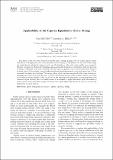Files in this item
Applicability of the capstan equation to guitar strings
Item metadata
| dc.contributor.author | Groves, Tom | |
| dc.contributor.author | Kemp, Jonathan Andrew | |
| dc.date.accessioned | 2019-11-08T10:30:05Z | |
| dc.date.available | 2019-11-08T10:30:05Z | |
| dc.date.issued | 2019-07-01 | |
| dc.identifier | 261336342 | |
| dc.identifier | 8cda2d62-77f2-4342-8a0f-9a50425ee21b | |
| dc.identifier | 85072179758 | |
| dc.identifier | 000484374800005 | |
| dc.identifier.citation | Groves , T & Kemp , J A 2019 , ' Applicability of the capstan equation to guitar strings ' , Archives of Acoustics , vol. 44 , no. 3 , pp. 459–465 . https://doi.org/10.24425/aoa.2019.129261 | en |
| dc.identifier.issn | 0137-5075 | |
| dc.identifier.other | ORCID: /0000-0002-3861-4863/work/62311850 | |
| dc.identifier.uri | https://hdl.handle.net/10023/18884 | |
| dc.description | Funding: Physics Trust Summer Scholarship from the School of Physics & Astronomy, University of St Andrews (TG). | en |
| dc.description.abstract | The effects of friction were observed in electric guitar strings passing over an electric guitar saddle. The effects of changing the ratio of the diameter of the winding to the diameter of the core of the string, the angle through which the string is bent, and the length on either side of the saddle were measured. Relative tensions were deduced by plucking and measuring the frequencies of vibration of the two portions of string. Coefficients of friction consistent with the capstan equation were calculated and were found to be lower than 0.26 for wound strings (nickel plated steel windings on steel cores) and lower than 0.17 for unwound (tin plated steel) strings. The largest values of friction were associated with strings of narrower windings and wider cores and this may be due to the uneven nature of the contact between the string and saddle for wound strings or due the surface of the windings deforming more, encouraging fresh (and therefore higher friction) metal to metal contact. It is advised to apply lubrication under the saddle to string contact point after first bringing the string up to pitch rather than before in order to prevent this fresh metal to metal contact. | |
| dc.format.extent | 7 | |
| dc.format.extent | 2356455 | |
| dc.language.iso | eng | |
| dc.relation.ispartof | Archives of Acoustics | en |
| dc.subject | Guitar | en |
| dc.subject | String | en |
| dc.subject | Friction | en |
| dc.subject | Saddle | en |
| dc.subject | Capstan equation | en |
| dc.subject | Bridge | en |
| dc.subject | MT Musical instruction and study | en |
| dc.subject | QC Physics | en |
| dc.subject | Acoustics and Ultrasonics | en |
| dc.subject | I-PW | en |
| dc.subject.lcc | MT | en |
| dc.subject.lcc | QC | en |
| dc.title | Applicability of the capstan equation to guitar strings | en |
| dc.type | Journal article | en |
| dc.contributor.institution | University of St Andrews. Music Centre | en |
| dc.identifier.doi | 10.24425/aoa.2019.129261 | |
| dc.description.status | Peer reviewed | en |
This item appears in the following Collection(s)
Items in the St Andrews Research Repository are protected by copyright, with all rights reserved, unless otherwise indicated.

